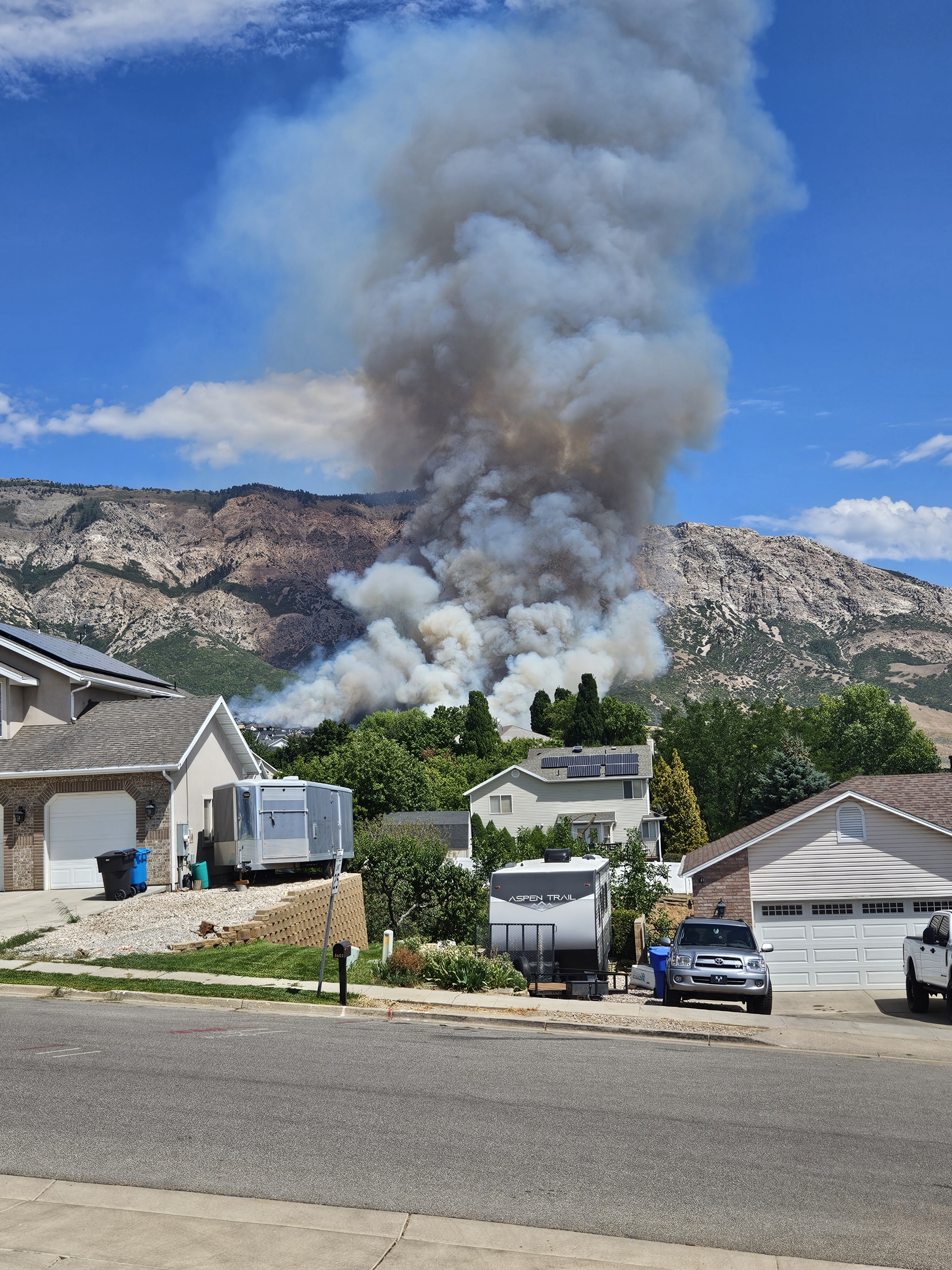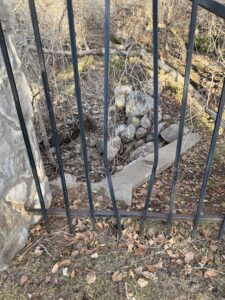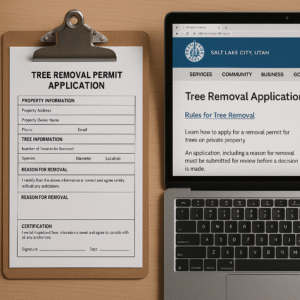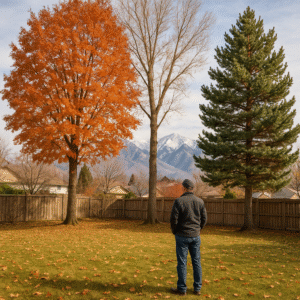 In 2025, Utah has had over 693 wildfires. Each time a fire occurs, it leaves behind destruction not only for the forest service, but for homeowners. If you have trees that have been burned, you must remove these trees or they can lead to safety risks. Here are five steps to safely remove fire damaged trees from your property.
In 2025, Utah has had over 693 wildfires. Each time a fire occurs, it leaves behind destruction not only for the forest service, but for homeowners. If you have trees that have been burned, you must remove these trees or they can lead to safety risks. Here are five steps to safely remove fire damaged trees from your property.
Understanding the Impact of Fire on Trees
Fire can have a catastrophic impact on trees, dramatically altering their structure, health, and stability. When flames engulf a tree, they can cause immediate and long-term damage to its bark, leaves, and root system. The intensity and duration of the fire play significant roles in determining the extent of the damage. For instance, a high-intensity fire can char the bark and penetrate deeply into the wood, compromising the tree’s ability to transport water and nutrients. This can lead to a weakened structure, making the tree more susceptible to falling over time.
Beyond the physical damage, fire can also stress the tree’s biological functions. The heat can kill essential microorganisms in the soil that support the tree’s health. The loss of foliage due to fire means that the tree loses its primary means of photosynthesis, affecting its growth and recovery. In some cases, trees may attempt to grow new leaves and branches, but if the root system has been severely damaged, this regrowth might be short-lived. It’s crucial to understand these impacts to determine whether a tree is salvageable or needs to be removed.
Fire-damaged trees can pose significant hazards to people and property. A tree weakened by fire can become unstable, with branches that are more likely to break and fall. This danger is particularly acute during storms or high winds. Assessing the health and stability of fire-damaged trees is an essential first step in the restoration process, ensuring that any decision to remove or retain a tree is based on a thorough understanding of the risks involved.
Assessing Fire-Damaged Trees: Safety First
Before undertaking any removal of fire-damaged trees, conducting a thorough assessment must be done to ensure safety. The first step is to inspect the tree visually from a distance, looking for obvious signs of instability such as leaning, cracks in the trunk, or broken branches.
Next, use a probing tool to test the integrity of the tree’s bark and trunk. Healthy bark should feel firm, while damaged bark may be brittle or charred. Pay particular attention to the base of the tree, as this area is crucial for the tree’s overall stability. If the base shows signs of significant damage, the tree is likely compromised and may need to be removed.
Another aspect of the tree assessment is evaluating the root system. Fire can cause extensive damage to the roots, which may not be immediately apparent. Check for signs of root burn or damage, such as exposed roots or soil that appears scorched. If the root system is compromised, the tree’s ability to stand upright is severely diminished, posing a significant safety risk.
Tools and Equipment Needed for Safe Tree Removal
One of the most critical tools for tree removal is a chainsaw. A high-quality chainsaw with a sharp blade and sufficient power is necessary to cut through thick branches and trunks.
You’ll need personal protective equipment (PPE) to ensure your safety. This includes a hard hat, safety goggles, ear protection, gloves, and steel-toed boots. Proper PPE protects you from falling debris, loud noises, and potential cuts or abrasions. It’s also advisable to wear long sleeves and pants to protect your skin from splinters and other hazards.
Other essential tools include ropes and harnesses for climbing and securing branches, wedges to prevent the saw from getting stuck, and a first aid kit in case of minor injuries. If the tree is particularly large or located near structures or power lines, you may need additional equipment such as a winch or crane.

Step-by-Step Guide to Removing Fire-Damaged Trees
Start by clearing the area around the tree, removing any debris or obstacles that could interfere with your work. Mark a clear escape route in case the tree falls unexpectedly. This route should be free of obstructions and lead to a safe distance from the tree.
Next, using your chainsaw, make a notch cut on the side of the tree facing the direction you want it to fall. This cut should be about one-third of the way through the trunk. The notch cut helps guide the tree’s fall and prevents it from splitting. After making the notch cut, move to the opposite side of the tree and make a felling cut slightly above the notch cut. This cut should be parallel to the ground and go through the remaining two-thirds of the trunk.
As you make the felling cut, keep an eye on the tree’s movement. If it starts to lean or shift, move to your escape route immediately. Once the tree begins to fall, stay clear until it has come to a complete rest. After the tree is down, use your chainsaw to cut the trunk into manageable sections, starting from the top and working your way down. Remove any remaining branches and dispose of them properly. By following these steps, you can safely remove fire-damaged trees and minimize the risk of injury or property damage.
Proper Disposal of Fire-Damaged Tree Debris
You need to properly dispose of the old trees so they do not cause a safety concern. Simply leaving the debris on the ground can create additional hazards, such as attracting pests or creating tripping dangers. Decomposing wood can contribute to further fire risks if not managed correctly. Wood chippers can break down branches and smaller logs into mulch, which can be used in your garden to improve soil quality and retain moisture.
You can also take your old trees to the local landfill. Many municipalities have specific guidelines for disposing of large tree debris, including designated drop-off sites or scheduled pick-up services. Ensure you follow local regulations to avoid fines or penalties. Renting a dumpster is another way to dispose of the old, fire damaged trees.
Restoring Your Landscape After Tree Removal
Once the fire-damaged trees and debris have been removed, the focus can shift to restoring your landscape. The first step in this process is to assess the soil quality. Fire can deplete essential nutrients and alter the soil’s pH balance, making it less hospitable for new plant growth. Conduct a soil test to determine its current condition and identify any necessary amendments. Adding compost or well-rotted manure can help replenish lost nutrients and improve soil structure.
Consider regrading the area if the removal of trees has left uneven ground or exposed roots. Leveling the soil and filling in any holes can provide a stable foundation for new plantings. This is also an excellent opportunity to aerate the soil, which can enhance water infiltration and root growth for future plants. Once the soil is prepared, you can begin planting new vegetation to replace the lost trees. Choose a mix of ground cover, shrubs, and other plants that are suited to your climate and soil conditions.
Irrigation is another crucial aspect of landscape restoration. Newly planted trees and plants require consistent watering to establish their root systems. Consider installing a drip irrigation system or soaker hoses to ensure efficient and even water distribution. Mulching around the base of new plants can help retain moisture and protect soil from erosion. By taking these steps, you can create a healthy and vibrant landscape that not only replaces what was lost but also enhances the beauty and functionality of your outdoor space.
Choosing the Right Replacement Trees for Your Landscape
Selecting the right replacement trees is a vital part of restoring your landscape after fire damage. Start by considering the specific environmental conditions of your area, such as soil type, climate, and available sunlight. Native species often make the best choices as they are adapted to local conditions and provide habitat for native wildlife. Additionally, native trees typically require less maintenance and are more resilient to local pests and diseases.
Another factor to consider is the growth rate and mature size of the trees. Fast-growing species can quickly provide shade and visual interest but may require more frequent pruning and maintenance. Conversely, slow-growing trees often have stronger wood and longer lifespans, making them a more sustainable choice in the long term. Think about the desired function of the trees in your landscape, whether it’s for shade, privacy, or ornamental value, and choose species that meet those needs.
It’s also essential to consider fire-resistant qualities when selecting replacement trees. Some species are more resistant to fire due to their moisture content, bark thickness, and growth habits. Trees with high moisture content, such as oaks and maples, are less likely to ignite and can act as natural firebreaks. Additionally, maintaining proper spacing between trees and regularly removing deadwood can further reduce fire risks. By thoughtfully selecting and planting the right trees, you can create a resilient and beautiful landscape that stands the test of time.
Preventative Measures to Protect Trees from Future Fires
Protecting your landscape from future fires involves implementing a series of preventative measures to reduce the risk of fire damage. One of the most effective strategies is creating defensible space around your property. This means maintaining a buffer zone free of flammable vegetation, debris, and other materials. Trim back branches that overhang roofs or come within 10 feet of structures, and regularly clear away dead leaves and underbrush.
Another key preventative measure is choosing fire-resistant plants and trees for your landscape. As mentioned earlier, some species are naturally less flammable and can help slow the spread of fire. Additionally, maintaining proper plant spacing and regularly pruning can reduce the amount of fuel available to a fire. Installing hardscaping features, such as gravel paths or stone walls, can also create natural firebreaks and enhance the overall aesthetic of your landscape.
Implementing a regular maintenance schedule is crucial for fire prevention. This includes watering your plants and trees adequately to keep them healthy and less prone to ignition. Inspect your landscape periodically for signs of disease or pest infestations, as unhealthy plants are more susceptible to fire. By staying vigilant and proactive, you can significantly reduce the risk of fire damage and protect your landscape for years to come.
Hiring Professional Tree Removal Services: When to Consider It
While some homeowners may feel confident handling tree removal themselves, there are situations where hiring professional tree removal services is the best course of action. If the fire-damaged trees are particularly large, located near structures or power lines, or if you lack the necessary equipment and expertise, it’s wise to call in professionals. Tree removal specialists have the training and experience to handle complex situations safely and efficiently.
Professionals can also provide a thorough assessment of your trees’ health and stability, offering valuable insights into whether certain trees can be saved or must be removed. They can identify hidden damage that may not be apparent to the untrained eye, such as internal rot or compromised root systems. Additionally, professional tree removal services are equipped with specialized tools and machinery, such as cranes and bucket trucks, to handle large or precariously positioned trees.
Hiring professionals can save you time, effort, and potential injury. Tree removal is a hazardous task that requires precise techniques and safety measures. By entrusting the job to experts, you can ensure that the removal process is conducted safely and that your property and surrounding landscape are preserved. When in doubt, it’s always better to err on the side of caution and seek professional assistance for tree removal.
Ensuring a Safe and Beautiful Landscape After Fire Damage
Restoring your landscape after fire damage is a challenging yet rewarding process. By understanding the impact of fire on trees, conducting thorough assessments, using the right tools, and following a step-by-step removal guide, you can safely remove fire-damaged trees and prepare your property for renewal. Proper disposal of debris and thoughtful restoration efforts, including soil improvement and the selection of appropriate replacement trees, are crucial for creating a healthy and resilient landscape.
Preventative measures, such as maintaining defensible space and choosing fire-resistant plants, can protect your property from future fires. Regular maintenance and vigilance are essential for reducing fire risks and ensuring the long-term health of your landscape. In situations where tree removal is particularly complex or hazardous, hiring professional services can provide peace of mind and ensure the job is done safely and effectively.
With careful planning and execution, you can transform a fire-damaged landscape into a thriving and beautiful outdoor space. Embrace the opportunity to rejuvenate your yard, fostering new growth and enhancing the natural beauty of your property. By taking these essential steps, you can restore not only your landscape but also your sense of safety and tranquility.





